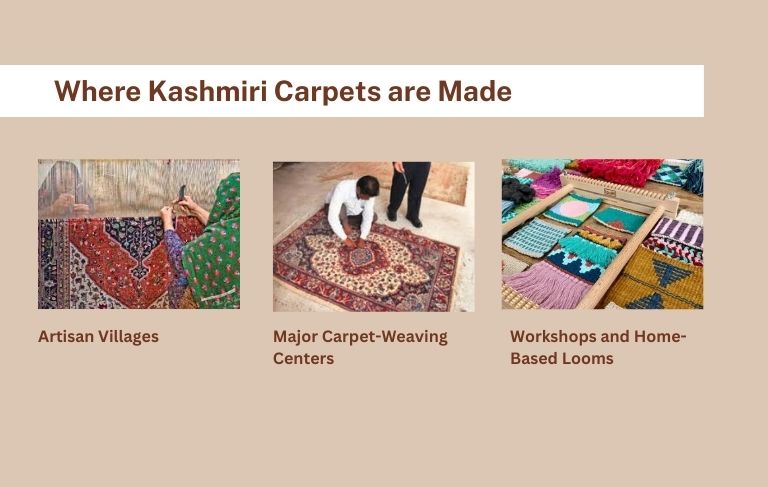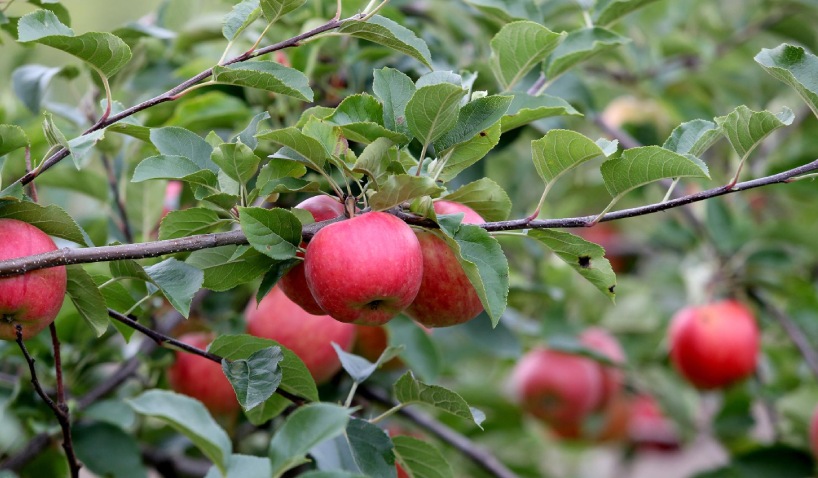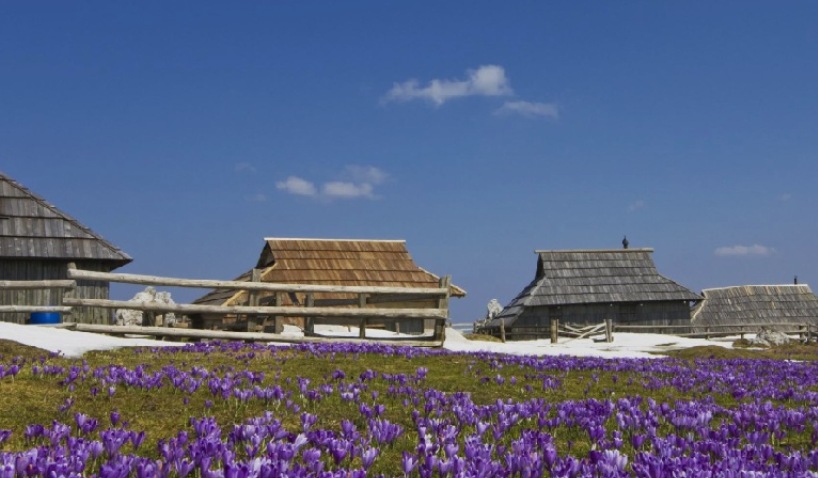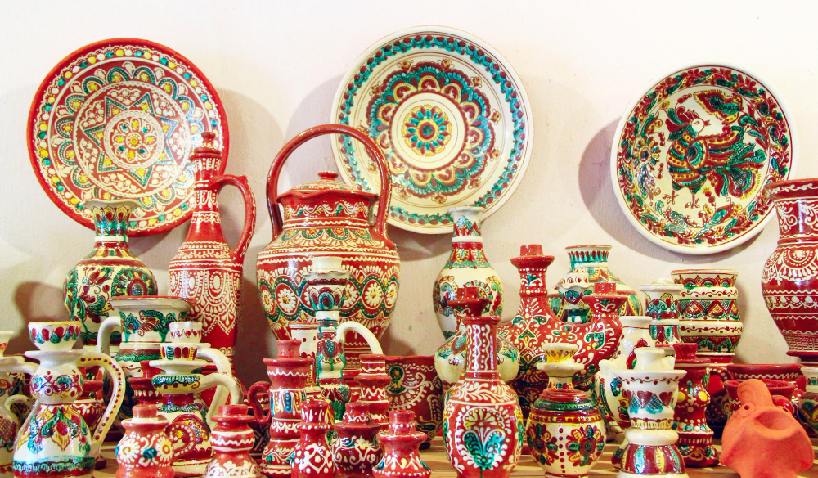Kashmiri Carpets :Handwoven Heritage for your home
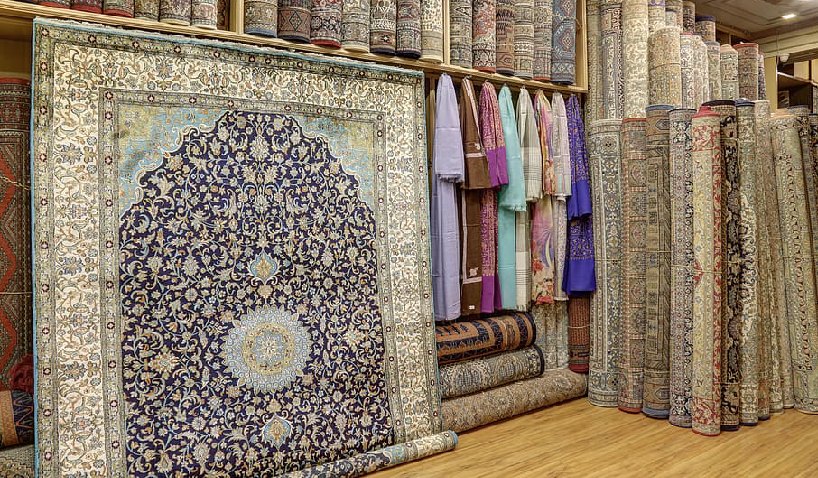
Kashmiri carpets are exquisite examples of handwoven craftsmanship that infuse any home with a sense of refinement and history. These carpets, which date back to the 15th century and were created by Persian artists who were invited by Sultan Zain-ul-Abidin, are renowned for their exquisite designs and superb workmanship. Using natural materials such as pure silk and wool, each carpet is painstakingly crafted with a high knot density, frequently involving hundreds of knots per square inch.
Beautiful handwoven carpets from Kashmir offer a sophisticated and traditional touch to any interior design. These carpets, which were created in the fifteenth century as a result of Persian artisans Sultan Zain-ul-Abidin invited, are renowned for their exquisite designs and superb workmanship. Each carpet is painstakingly made from natural materials such as pure silk and wool, with a high knot density that frequently entails hundreds of knots per square inch.
The Rich History of Kashmiri Carpets
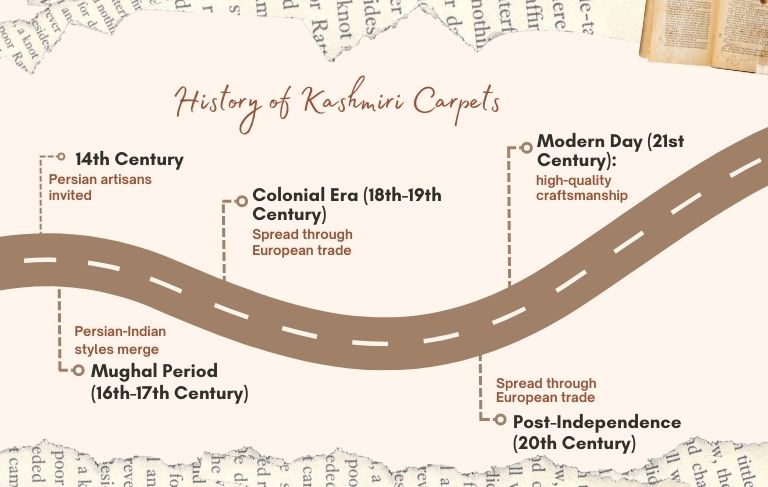
The rich tapestry of tradition, culture, and artistic brilliance that is the history of Kashmiri carpets. The tale of these carpets starts in the fifteenth century, when the visionary Sultan Zain-ul-Abidin introduced Persian artisans to Kashmir, giving rise to the carpet industry. The skill of carpet weaving flourished under their direction, developing over centuries to incorporate a distinctive Kashmiri aesthetic.
The development of Kashmiri carpets is evidence of the region’s creative inventiveness and diversity of culture. Persian, Central Asian, and regional Indian customs all had an influence on the development of the distinctive features that made Kashmiri carpets unique. The rich cultural tapestry of the Kashmiri carpet artistry is reflected in its elaborate designs, complex motifs, and vivid colors.
Beyond their visual appeal, Kashmiri carpets have cultural significance. These carpets, which represent centuries of artistry and custom, act as material representations of Kashmiri heritage. They are treasured heirlooms handed down through the generations that are more than just floor coverings; each one bears the mark of the skill and devotion of its artisans.
Kashmiri carpets are the product of a labor of love and artisanship that demands patience, accuracy, and a profound knowledge of the craft. Each carpet is painstakingly hand-woven by artisans utilizing age-old methods that have been handed down through the generations. Even though the process is laborious and can take months to finish a single piece, the end product is a masterpiece of unmatched quality and beauty.
Kashmiri carpets are still highly valued today due to their superb workmanship and classic style. All across the world, they adorn houses and galleries as a constant reminder of Kashmir’s rich artistic and cultural legacy. Let’s honor the craftspeople whose talent and commitment preserve the art of Kashmiri carpet weaving as we marvel at these magnificent works of art.
The development of Kashmiri carpets is evidence of the region’s creative inventiveness and diversity of culture. Persian, Central Asian, and regional Indian customs all had an influence on the development of the distinctive features that made Kashmiri carpets unique. The rich cultural tapestry of the Kashmiri carpet artistry is reflected in its elaborate designs, complex motifs, and vivid colors.
Beyond their visual appeal, Kashmiri carpets have cultural significance. These carpets, which represent centuries of artistry and custom, act as material representations of Kashmiri heritage. They are treasured heirlooms handed down through the generations that are more than just floor coverings; each one bears the mark of the skill and devotion of its artisans.
Kashmiri carpets are the product of a labor of love and artisanship that demands patience, accuracy, and a profound knowledge of the craft. Each carpet is painstakingly hand-woven by artisans utilizing age-old methods that have been handed down through the generations. Even though the process is laborious and can take months to finish a single piece, the end product is a masterpiece of unmatched quality and beauty.
Kashmiri carpets are still highly valued today due to their superb workmanship and classic style. All across the world, they adorn houses and galleries as a constant reminder of Kashmir’s rich artistic and cultural legacy. Let’s honor the craftspeople whose talent and commitment preserve the art of Kashmiri carpet weaving as we marvel at these magnificent works of art.
Key Points
- Kashmiri carpets originated in the 15th century with the arrival of Persian artisans in the region.
- They developed to combine Indian, Persian, and Central Asian elements, resulting in a distinctly Kashmiri style.
- Kashmiri carpets are emblems of custom and artistry and represent the region’s rich cultural legacy.
- Generations of artisans employ painstaking hand-weaving techniques to preserve their craft.
- The sector grew in prominence throughout the world, exporting carpets via the historic Silk Road trade routes and continuing to be a significant driver of the Kashmiri economy.
Artisan Techniques and Process of Kashmiri Carpets
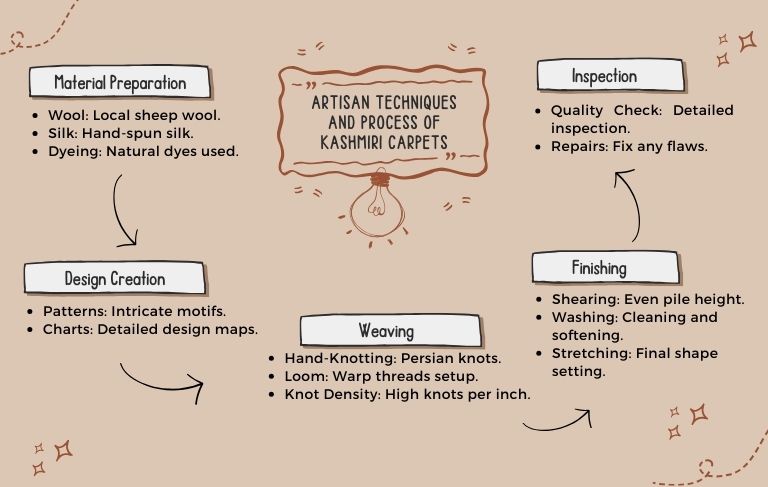
Kashmiri carpets are made using artisan methods and procedures that are deeply ingrained in tradition and call for exacting skill and attention to detail. This is a synopsis:
- Design: The process starts with the creation of elaborate patterns and motifs by trained artisans. Nature, Persian art, and traditional Kashmiri art are common sources of inspiration for these designs.
- Material Selection: When making Kashmiri carpets, premium materials are needed. Craftsmen meticulously choose premium quality fibers by handpicking either pure silk, wool, or a combination of the two.
- Dyeing: Vibrant and long-lasting colors are typically achieved through the use of natural vegetable dyes. Using age-old recipes that have been handed down through the generations, artisans make the dyes from organic materials like plants, roots, and minerals.
- Configuring the Loom: The loom is adjusted based on the intended carpet’s dimensions and pattern. To guarantee that the warp threads are tensioned and spaced evenly, this process needs to be done precisely.
- Knotting: The genuine artistry of Kashmiri carpet weaving is revealed during the knotting process. Using methods like the Turkish or Persian knots, artisans painstakingly tie each knot by hand. The intricate design and longevity of the carpet are determined by the density of knots per square inch.
- Weaving: As the knotting progresses, the pattern begins to take shape. Skilled artisans use specialized tools such as a shuttle to weave the weft threads through the warp, securing the knots in place.
- Final Touches: The carpet goes through a number of finishing procedures after weaving is finished. This entails cleaning the carpet to get rid of extra dye, stretching it to guarantee the right shape and size, and cutting the pile to create an even surface.
- Detailing and Embellishments: Additional detailing and embellishments, like silk highlights, metallic threads, or carved wooden borders, can be found on some Kashmiri carpets. These components enhance the carpet’s overall beauty by giving the design more depth and complexity.
- Quality Control: Each Kashmiri carpet is put through a rigorous inspection process to guarantee that it meets the highest standards of durability and craftsmanship before it is considered complete.
- Legacy and Continuation: The craft of weaving Kashmiri carpets is frequently a family tradition, with generations of people passing down the necessary skills. The artisans continue to innovate while adhering to the time-honored methods that characterize Kashmiri carpets, and they take great pride in maintaining this traditional craft.
Hand Weaving techniques of Kashmiri Carpets
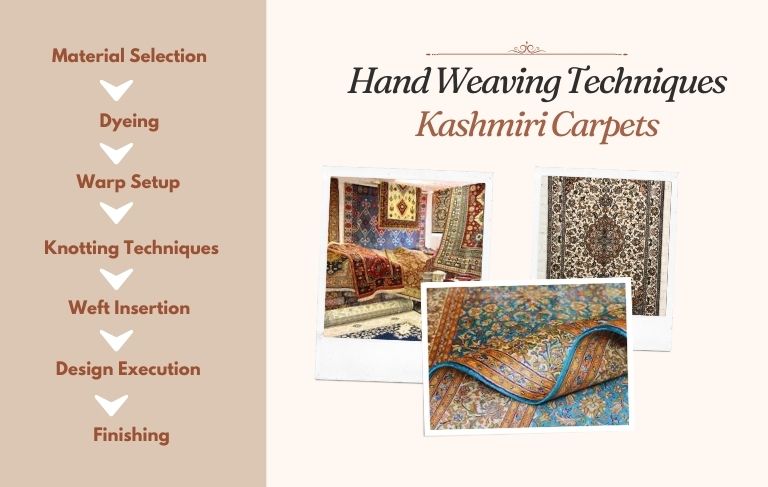
Kashmiri carpets are made entirely by hand, with hand weaving techniques contributing significantly to the exquisite detail and superior quality of each piece. Here is a summary of some of the most important hand weaving methods used in the creation of Kashmiri carpets:
Hand Knotting:
The exquisite hand-knotted structure of Kashmiri carpets is well known. To create the pile of the carpet, artisans painstakingly tie individual knots by hand onto the warp threads. Each knot adds to the carpet’s overall density, durability, and texture, so this process calls for accuracy and skill.Pile Weaving:
To secure the knots in place and create the foundation of the carpet, the weft threads are passed through the warp threads after the knots have been tied. Kashmiri carpets are renowned for their opulent and velvety texture, which is achieved through the meticulous weaving of pile yarns in between warp threads.Persian Knot Technique:
Also referred to as the asymmetrical knot, the Persian knot is the most widely used knotting technique in Kashmiri carpet weaving. Using this method, a unique diagonal pattern is made in the surface of the carpet by wrapping the yarn around one warp thread and then pulling it through to form a loop.Senneh Knot Technique:
Another knotting technique employed in Kashmiri carpet making is the Senneh knot, also known as the symmetrical knot. Similar to the Persian knot, the yarn is wrapped around two adjacent warp threads and then pulled through to form a symmetrical loop. This technique results in a different texture and pattern compared to the Persian knot.Double Knotting:
To increase the durability and density of some Kashmiri carpets, especially those with complex designs and high knot densities, artisans may employ the double knotting technique. By knotting each warp thread twice as opposed to once, this technique produces a denser pile and more detailed design elements.Shearing:
To reveal the intricate patterns and achieve a smooth, uniform finish, the carpet’s surface is sheared to an even height after the weaving process is finished. Using specialized tools, skilled artisans carefully trim the pile to the desired length, maximizing the display of the carpet’s design.How Are Kashmiri Carpets Crafted with Natural Materials
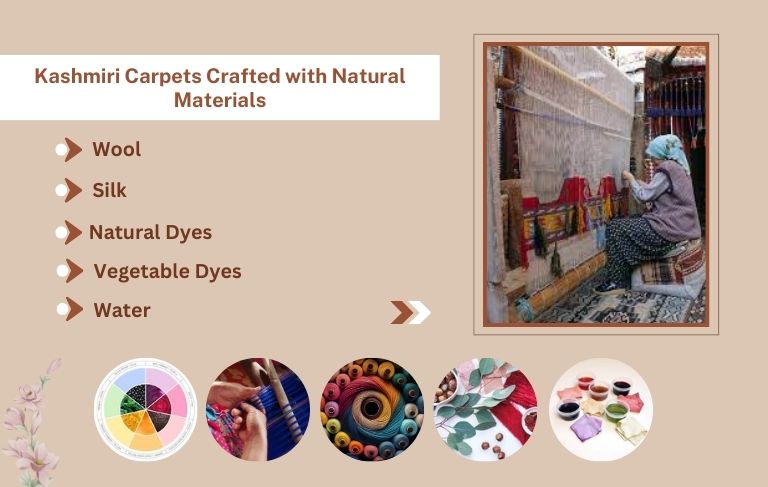
The art of making Kashmiri carpets from natural materials has been practiced for centuries. Skilled craftsmen use traditional methods to produce exquisite carpets made from sustainable and locally sourced materials. Here’s how natural materials are used to create Kashmiri carpets:
Wool:
- The main material used in Kashmiri carpet weaving is wool, which is valued for its inherent insulating qualities, softness, and durability.
- Craftspeople obtain superior wool from indigenous sheep breeds, including Changthangi, Malabar, and Pashmina, which are recognized for their silky, lengthy strands.
- Only the finest fibers are used in the carpet-making process because the wool is meticulously cleaned, carded, and spun by hand before being woven.
Silk:
- Another precious material used in Kashmiri carpet weaving is silk, which is valued for its vivid colors and glossy texture.
- Silk is frequently used by artisans to incorporate fine motifs and highlights into their carpets, producing striking contrasts against the woolen background.
- Usually obtained from silkworm cocoons, silk fibers are hand-spun and hand-dyed by artisans to produce the desired textures and colors.
Natural Dyes:
- The rich, vivid colors of Kashmiri carpets, which are produced by using natural dyes sourced from plant, mineral, and insect sources, are among their most characteristic qualities.
- To make dyes, artisans employ a variety of organic resources such as saffron, walnut shells, pomegranate rind, indigo, and madder root.
- In order to extract the desired pigments and create the ideal shade, dyers meticulously boil, soak, and ferment the raw materials. Each dyeing process is a labor-intensive art form.
Vegetable Dyes:
- An eco-friendly and subdued color palette characterizes vegetable dyes, which are a subset of natural dyes made exclusively from plant sources.
- Plant materials such as leaves, roots, bark, and flowers are used by artisans to make vegetable dyes that come in a range of earthy tones and gentle pastels.
- Because they can produce subtle color and depth variations, vegetable dyes are preferred for giving Kashmiri carpets a sense of authenticity and natural beauty.
Water:
- Water is used extensively in the carpet-making process as a medium for washing and finishing the completed carpets as well as a solvent for dying them.
- Throughout the creation process, local rivers, streams, and natural springs provide the pure, clean water that artisans need to maintain the integrity and quality of their carpets.
Unique Features of Kashmiri Carpets
Carpets from Kashmir are well known throughout the world for their outstanding craftsmanship, remarkable quality, and unique visual appeal. Kashmiri carpets differ from other carpet types in a few distinctive ways:
Exquisite Hand-Knotted Design:
Skilled artisans painstakingly hand-knot Kashmiri carpets, tying each knot onto the warp thread by hand. The carpets produced by this labor-intensive process have remarkable quality, texture, and longevity.Detailed Patterns and Designs:
The elaborate patterns and designs of Kashmiri carpets, which frequently take inspiration from Mughal art, Persian motifs, and the natural world, make them highly valued. Traditional methods like the Persian and Senneh knots are used by artisans to craft intricate floral, geometric, and paisley designs that add a timeless elegance to the carpets.Vibrant, Rich Colors:
The rich, vivid colors of Kashmiri carpets, which are produced by using natural dyes derived from plant, mineral, and insect sources, are among their most remarkable qualities. The allure and beauty of Kashmiri carpets are enhanced by the depth and luminosity that these natural dyes produce, which are unmatched by synthetic dyes.Silky Feel and Indulgent Pile:
Kashmiri carpets are highly valued for their plush pile and silky texture, which give them a velvety, opulent feel underfoot. Silk accents are a common way for artisans to draw attention to specific details and accentuate texture in their carpets, which enhances the carpets’ tactile richness and visual appeal.Longevity and Durability:
Kashmiri rugs are incredibly strong and long-lasting because of their exquisite hand-knotted design and premium materials. These carpets are a timeless investment for any home because they can last for generations with the right upkeep and care.Artistry and Cultural Heritage:
Kashmiri carpets are the epitome of a long-standing, artisanal tradition and rich cultural legacy. Every carpet is a work of love, infused with the artistry, ingenuity, and skill of generations of Kashmiri artisans who have spent centuries perfecting their trade.Flexibility and Modularity:
Because of their adaptability and versatility, Kashmiri carpets go well with a variety of interior design themes and styles. These carpets provide warmth, style, and sophistication to any area, whether they are utilized as a focal point in an elegant living room or as a soft accent in a study or bedroom.Why Choose a Kashmiri Carpet for Your Home
There are many reasons to choose a Kashmiri carpet for your house; it’s an investment that will last a lifetime and improve the aesthetics and comfort of your living area. The following are some strong arguments in favor of getting a Kashmiri carpet for your house:
Unsurpassed Craftsmanship and Quality:
Kashmiri carpets are known for their superb quality and workmanship; each piece is painstakingly hand-knotted by knowledgeable artisans utilizing age-old methods that have been passed down through the generations. The end product is a carpet that elevates any space with its unmatched beauty, toughness, and texture.Aesthetic appeal and timeless elegance:
Kashmiri carpets radiate classic elegance and visual appeal with their elaborate designs, vivid colors, and luxurious pile. There is a Kashmiri carpet to fit every style and taste, with its exquisite beauty and sophistication enhancing the décor of your home. Traditional floral motifs, geometric patterns, or modern interpretations are all available.Artistic Legacy and Cultural Heritage:
Choosing a Kashmiri carpet for your house means embracing a rich cultural and artistic legacy in addition to obtaining a stylish piece of furniture. Every carpet is an homage to the ability, inventiveness, and legacy of Kashmiri weavers, who have honed their craft over centuries, giving each one a unique sense of provenance and authenticity.Adaptability and Versatility:
Kashmiri carpets can be used in a variety of interior décor styles and settings because of their versatility and adaptability. A Kashmiri carpet adds warmth, texture, and visual interest to any space, enhancing its overall ambiance and character, whether it is used as a desk covering, a statement piece in an elegant living room, or even just as a wall hanging.Investment Worth and Lifespan:
Kashmiri carpets are a wise investment for the future because of their exceptional quality, timeless appeal, and longevity, even though they may require a higher initial investment than mass-produced alternatives. A Kashmiri carpet can be a treasured heirloom that is passed down through your family for many years to come with the right upkeep and care. It can maintain its beauty and value for generations.Essential Tips for Caring Kashmiri Carpets
To maintain your Kashmiri carpet’s beauty, longevity, and value, care is necessary. Here are some thorough instructions for taking good care of and maintaining your Kashmiri carpet:
Frequently Vacuuming:
Frequent vacuuming of your carpet will help to eliminate dust and debris buildup within the fibers. To prevent breaking the fragile fibers, use a vacuum with a mild suction setting. To preserve the texture and appearance of the carpet, vacuum in the direction of the pile.Steer clear of direct sunlight.
The hues of your Kashmiri carpet may fade with prolonged exposure to direct sunlight. To shield the carpet from direct sunlight, place it in a shaded area or cover it with blinds and curtains. Rotate the carpet if it is exposed to sunlight on a regular basis to guarantee even exposure and avoid uneven fading.Turn the carpet around:
To guarantee even wear and tear, rotate your Kashmiri carpet every six months to a year. This keeps the carpet’s overall appearance and condition intact by preventing some areas from becoming more worn or faded than others.Employ Carpet Cushions:
Underneath your Kashmiri carpet, place an excellent carpet pad or underlay. This lessens wear, adds cushioning, and keeps the carpet from slipping. Additionally, it aids in mitigating the effects of foot traffic, maintaining the structure and aesthetic appeal of the carpet.Controlling Humidity:
Keep the humidity in the space where your Kashmiri carpet is installed at a constant level. Severe variations in humidity can lead to expansion and contraction of natural fibers, which may result in damage. If required, use a dehumidifier or humidifier to regulate the humidity levels.Where to Buy Authentic Kashmiri Carpets

When looking to buy authentic Kashmiri carpets, it’s essential to choose reputable sources to ensure you’re getting a genuine, high-quality product. Here are some recommended places to buy authentic Kashmiri carpets:
1 .Kashmir’s regional artisans and workshops:
Buying directly from Kashmiri craftsmen and workshops is one of the best ways to guarantee authenticity. This helps the local economy and craftspeople while also ensuring the carpet’s quality and authenticity.2. Approved Stores and Boutiques:
Seek out authorized merchants and shops that specialize in offering Kashmiri carpets that are handmade and traditional. These shops are frequently known for their authenticity and high caliber. Among the well-known ones are:- Kashmir Oriental Carpet Enterprises in Srinagar.
- Ahdoos Carpet Factory in Srinagar.
- Cottage Emporium (various locations in India).
3. Online Retailers with Authenticity Guarantees:
There are several reputable online retailers that offer authentic Kashmiri carpets with certification of authenticity and detailed product descriptions. Ensure the online store has positive reviews and return policies. Some trustworthy online platforms include:- Etsy: Look for sellers with high ratings and positive reviews.
- CarpetVista: Offers a wide selection of handwoven Kashmiri carpets with authenticity certificates.
- RugKnots: Specializes in handmade rugs, including Kashmiri carpets, and provides detailed information about each product.
Government Handicraft Emporiums:
Many Indian states have government-run handicraft emporiums that sell authentic Kashmiri carpets. These emporiums are reliable sources as they work directly with local artisans and provide authenticity certificates. Some well-known ones include:- Central Cottage Industries Emporium (CCIE) in Delhi.
- Kashmir Government Arts Emporium in Srinagar.
International Trade Shows and Exhibitions:
Authentic Kashmiri carpet sellers often have booths at international trade shows and exhibitions. Attending these events gives you the chance to talk with the carpet sellers face-to-face and feel the carpets firsthand. Among the noteworthy trade exhibits are:- Domotex in Hannover, Germany.
- The Rug Show in New York, USA.
- Maison & Objet in Paris, France.
Where Kashmiri Carpets are Made
